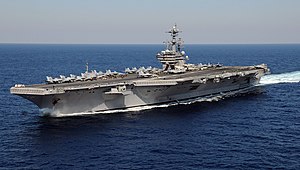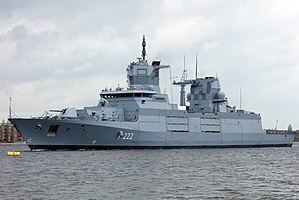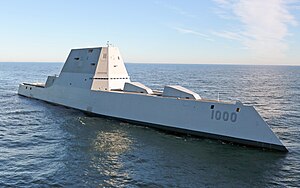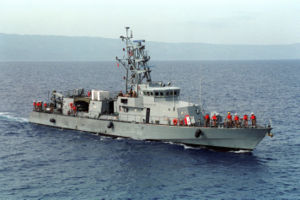Zamastanian Naval Forces
| Zamastanian Naval Forces Z.N.F. | |
|---|---|
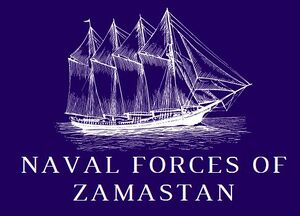 Embelm of the Zamastanian Navy | |
| Active | September 3rd, 1805 |
| Country | Zamastan |
| Allegiance | Government of Zamastan, President of Zamastan |
| Branch | Navy |
| Size | Total - 296,500 |
| Fleet |
|
| Engagements | |
| Commanders | |
| President of Zamastan | Atticus Moreau |
| Secretary of Defense | Camille Boffrand |
| Secretary of the Navy | Antoine Porter |
| Chief of Naval Operations | Sam Armstrong |
| 1st Fleet Admiral | Elliot Holloway |
| 2nd Fleet Admiral | Ross Cummings |
| 3rd Fleet Admiral | Ashton Sheppard |
| 4th Fleet Admiral | Drew Barr |
| 5th Fleet Admiral | Rebecca Chaney |
The Zamastanian Naval Forces (ZNF), also referred to as the Zamastanian Navy and Marine Corps, is the naval warfare force of Zamastan, operating under the overarching authority of the Zamastanian Armed Forces. It includes the Zamastanian Navy and the Marines. The Navy maintains a fleet of technologically sophisticated ships and submarines including seven aircraft carriers, amphibious transport docks, ballistic missile submarines, six nuclear fleet submarines, guided missile destroyers, frigates, corvettes, mine-countermeasure vessels and patrol vessels. It has 240 deployable combat vessels and more than 3,100 operational aircraft as of January 2020. The Zamastanian Air Force replenishes ZNF warships at sea, and augments the Navy's amphibious warfare capabilities through its three Bay-class landing ship vessels. It also works as a force multiplier for the Navy, often doing patrols that frigates used to do. The total displacement of the Navy is approximately 408,750 tonnes (706,759 tonnes including the Zamastan Fleet Auxiliary and Marines).
History
Personnel
The Zamastanian Naval Forces has over 296,500 personnel, approximately a quarter of whom are in ready reserve. Of those on active duty, more than eighty percent are enlisted sailors and around fifteen percent are commissioned officers; the rest are midshipmen of the Zamastanian Naval Academy in Jade Harbor and midshipmen of the Naval Reserve Officer Academy at over 180 universities around the country and officer candidates at the Navy's Officer Candidate Center. Enlisted sailors complete basic military training at boot camp and then are sent to complete training for their individual careers.
Sailors prove they have mastered skills and deserve responsibilities by completing Personnel Qualification Standards (PQS) tasks and examinations. Among the most important is the "warfare qualification", which denotes a journeyman level of capability in Surface Warfare, Aviation Warfare, Information Dominance Warfare, Naval Aircrew, Special Warfare, Seabee Warfare, Submarine Warfare or Expeditionary Warfare. Many qualifications are denoted on a sailor's uniform with Zamastanian Navy badges and insignia.
Fleet Commanders and admirals
1st Fleet
- 1st Fleet Admiral - Elliot Holloway
- Admiral - Abraham Murray
- Vice admiral - Isaiah Morrison
- Rear admiral - Richard Scott
- Rear admiral - Henry Bourne
2nd Fleet
- 2nd Fleet Admiral - Ross Cummings
- Admiral - Clement Kisiner
- Vice admiral - Degory McCalla
- Rear admiral - Seth Pennel
- Rear admiral - William Oliver
3rd Fleet
- 3rd Fleet Admiral - Ashton Sheppard
- Admiral - Giles Woodbury
- Vice admiral - Elihu Collins
- Rear admiral - Isham Sinclair
- Rear admiral - Noble Crockett
4th Fleet
- 4th Fleet Admiral - Drew Barr
- Admiral - Israel Williamson
- Vice admiral - Isaac Ross
- Rear admiral - Elisha Sterrett
- Rear admiral - Elias Kenly
5th Fleet
- 5th Fleet Admiral - Rebecca Chaney
- Admiral - Josiah Barnett
- Vice admiral - Salmon Cowan
- Rear admiral - Zaccheus Ramsey
- Rear admiral - Gideon Irwin
6th Fleet
- 6th Fleet Admiral - Aubin Beauvais
- Admiral - Christopher Gest
- Vice admiral - Eliakim Bradley
- Rear admiral - Obadiah Moffett
- Rear admiral - Richard Brannon
Equipment
Ships
Aircraft carriers
An aircraft carrier is typically deployed along with a host of additional vessels, forming a carrier strike group. The supporting ships, which usually include three or four Orion-equipped (powerful computer and radar technology to track and guide weapons to destroy enemy targets) cruisers and destroyers, a frigate, and two attack submarines, are tasked with protecting the carrier from air, missile, sea, and undersea threats as well as providing additional strike capabilities themselves. Ready logistics support for the group is provided by a combined ammunition, oiler, and supply ship.
Instead of the gas turbines or diesel-electric systems used for propulsion on many modern warships, the carriers use two pressurized water reactors which drive four propeller shafts and can produce a maximum speed of over 30 knots (56 km/h; 35 mph) and maximum power of around 260,000 shaft horsepower (190 MW). As a result of the use of nuclear power, the ships are capable of operating for over 20 years without refueling and are predicted to have a service life of over 50 years. The first Talon-class carrier, the ZMS Griffiths, was commissioned in 1981.
The Navy has a statutory requirement for a minimum of 7 aircraft carriers. The navy is currently consistant of nine Talon-class nuclear aircraft carrier, with the ZMS Castovia (formerly Gardner) undergoing extensive systems and technologies testing until around 2021, and the eighth and ninth carriers, ZMS Gaviria and ZMS Abotsford, having launched in late 2022 and early 2023 respectively. Additionally, the ZMS Daniels is being constructed and is set to launch in early 2024. All modern-day carriers are named after presidents of Zamastan, currently being Alistair Griffiths, Tyler Kordia, Thomas Dubois, Jean Levasseur, Caius Aebutius, Quintus Belisarius, William Castovia, Marvin Gaviria, Elene Abotsford, and Elijah Daniels. The ZMS Gardner, named after Hawk Gardner, was renamed the ZMS Castovia on September 23rd, 2021.
During the World War, the Upham-class aircraft carrier names were varied, often composed of military leader namesakes, with the ZMS Upham being the class' flagship. The Upham-class ships were constructed between 1940-1960. The immediate post-World War carriers, the Hamilton-class aircraft carrier, were built between 1959-1974. All of these vessels have either been decomissioned or have been sold to nations friendly with Zamastan.
- ZMS Griffiths - launched 1981, ZNB Jade Harbor
- ZMS Kordia - launched 1984, ZNB Jade Harbor
- ZMS Dubois - launched 1989, ZNB Tregueux
- ZMS Levasseur - launched 1991, ZNB Anchorhead
- ZMS Aebutius - launched 1993, ZNB Aurelia
- ZMS Belisarius - launched 2009, ZNB Aurelia
- ZMS Castovia - launched 2014, ZNB Holish Islands
- ZMS Gaviria - launched 2022, ZNB Tregueux
- ZMS Abotsford - launched 2023, ZNB Tofino
- ZMS Daniels - launched 2024, ZNB Jade Harbor
Amphibious warfare vessels
Amphibious assault ships are the centerpieces of Zamastanian amphibious warfare and fulfill the same power projection role as aircraft carriers. However, their striking force centers on land forces instead of aircraft. They deliver, command, coordinate, and fully support all elements of a 2,000-men-strong Unit in an amphibious assault using both air and amphibious vehicles.
Cruisers
Cruisers are large surface combat vessels that conduct anti-air/anti-missile warfare, surface warfare, anti-submarine warfare, and strike operations independently or as members of a larger task force. Modern guided missile cruisers were developed out of a need to counter the anti-ship missile threat facing the Zamastanian Navy. Cruisers are named after geographic names in Zamastan, often cities, rivers, or mountains.
- ZMS Monserrati (CG 119)
- ZMS Trisiona (CG 120)
- ZMS Maple Wind (CG 121)
- ZMS Clift (CG 122)
- ZMS Birchwood (CG 123)
- ZMS Abagene (CG 124)
- ZMS Tariel (CG 125)
- ZMS Tofiniua (CG 126)
- ZMS Durassi (CG 127)
- ZMS Leprino (CG 128)
- ZMS Jarossina (CG 129)
- ZMS White Rock (CG 130)
- ZMS Estern (CG 131)
- ZMS Grouse (CG 132)
- ZMS Qira (CG 133)
- ZMS Serenity (CG 134)
- ZMS Sundress (CG 135)
- ZMS Maina (CG 136)
- ZMS Brattollion (CG 137)
- ZMS Tronhede (CG 138)
- ZMS Fougere (CG 139)
- ZMS Alabaster (CG 140)
- ZMS Sunlam (CG 141)
- ZMS Elkhead (CG 142)
- ZMS Blythe (CG 143)
- ZMS Maycastle (CG 144)
- ZMS Torport (CG 145)
- ZMS Summercord (CG 146)
- ZMS Elmhill (CG 147)
- ZMS Dorburn (CG 148)
- ZMS Falwood (CG 149)
- ZMS Harboro (CG 150)
- ZMS Verrane (CG 151)
- ZMS Ellingter (CG 152)
- ZMS Northland (CG 153)
- ZMS Shawville (CG 154)
- ZMS Angenta (CG 155)
- ZMS Coviso (CG 156)
- ZMS Alcala (CG 157)
- ZMS Alkfort (CG 158)
- ZMS Lisney (CG 159)
- ZMS Dundare (CG 160)
- ZMS Winterschede (CG 161)
- ZMS Malnon (CG 162)
- ZMS Eastbar (CG 163)
- ZMS Siera (CG 164)
- ZMS Venpon (CG 165)
- ZMS Tralina (CG 166)
- ZMS Maycastle (CG 167)
- ZMS Calwaki (CG 168)
- ZMS Auckandia (CG 169)
- ZMS Verburg (CG 170)
- ZMS Tourzen (CG 171)
- ZMS Sadine (CG 172)
Destroyers
Destroyers are multi-mission medium surface ships capable of sustained performance in anti-air, anti-submarine, anti-ship, and offensive strike operations. Like cruisers, guided missile destroyers are primarily focused on surface strikes using the Firebird Land Attack Missiles and fleet defense through missile systems. As in the case of frigates, destroyers are named after Navy, Marine, and Coast Guard heroes, with the flagship destroyer of the Percilius-class being named the ZMS Lance Pelio after famed World War Admiral Lance Pelio, and the flagship of the Pemberton-class being the ZMS Peletier after Admiral Crade Peletier.
Percilius-class
- ZMS Lance Pelio (DDG 001)
- ZMS Tobias (DDG 002)
- ZMS Altendorf (DDG 003)
- ZMS Jackson (DDG 004)
- ZMS Loan (DDG 005)
- ZMS Biggy (DDG 006)
- ZMS Cassiday (DDG 007)
- ZMS Shorthand (DDG 008)
- ZMS Keiper (DDG 009)
- ZMS Andrews (DDG 010)
- ZMS Church (DDG 011)
- ZMS Lennox (DDG 012)
- ZMS Raydan (DDG 013)
- ZMS Hill (DDG 014)
- ZMS Herring (DDG 015)
- ZMS Byrne (DDG 016)
- ZMS Gallagher (DDG 017)
- ZMS Tecna (DDG 018)
- ZMS Moss (DDG 019)
- ZMS Brady (DDG 020)
- ZMS Engebos (DDG 021)
- ZMS Guild (DDG 022)
- ZMS Artego (DDG 023)
- ZMS Feist (DDG 024)
- ZMS Guillaume (DDG 025)
- ZMS Vidal (DDG 026)
- ZMS Saunier (DDG 027)
- ZMS Émilien (DDG 028)
- ZMS Adnet (DDG 029)
- ZMS Mathieu (DDG 030)
- ZMS Boudier (DDG 031)
- ZMS Charbonneau (DDG 032)
- ZMS Jacquet (DDG 033)
- ZMS Ilonna (DDG 034)
- ZMS Fragale (DDG 035)
- ZMS Tolomeo (DDG 036)
- ZMS Mercia (DDG 037)
- ZMS Emerson (DDG 038)
- ZMS Galena (DDG 039)
- ZMS Westenra (DDG 040)
- ZMS Kamura (DDG 041)
- ZMS Fortuna (DDG 042)
- ZMS Peters (DDG 043)
- ZMS Rolando (DDG 044)
- ZMS Pellitteri (DDG 045)
- ZMS Labruzzo (DDG 046)
- ZMS Lieto (DDG 047)
- ZMS Goffredo (DDG 048)
- ZMS Crose (DDG 049)
- ZMS Ciancio (DDG 050)
- ZMS Narsete (DDG 051)
- ZMS Euseo (DDG 052)
- ZMS Celio (DDG 053)
- ZMS Natale (DDG 054)
- ZMS Tomasulo (DDG 055)
- ZMS Eustorgio (DDG 056)
- ZMS Scarangella (DDG 057)
- ZMS Federico (DDG 058)
- ZMS Girolamo (DDG 059)
- ZMS Crispino (DDG 060)
- ZMS Frattaroli (DDG 061)
- ZMS Quentin (DDG 062)
- ZMS Amaury (DDG 063)
- ZMS Allemand (DDG 064)
- ZMS Erruin (DDG 065)
- ZMS Rémy (DDG 066)
- ZMS Natanael (DDG 067)
- ZMS LaRue (DDG 068)
- ZMS Djeferson (DDG 069)
- ZMS Pascal (DDG 070)
- ZMS Gigot (DDG 071)
Pemberton-class
- ZMS Zacharie (DDG 072)
- ZMS Peletier (DDG 073)
- ZMS Gounelle (DDG 074)
- ZMS Granet (DDG 075)
- ZMS Bacque (DDG 076)
- ZMS Gabriel (DDG 077)
- ZMS Barbeau (DDG 078)
- ZMS Coquelin (DDG 079)
- ZMS Lucien (DDG 080)
- ZMS Mesny (DDG 081)
Frigates and Littoral combat ships

Modern frigates and littoral combat ships mainly perform anti-submarine warfare for carrier and expeditionary strike groups and provide armed escort for supply convoys and merchant shipping. They are designed to protect friendly ships against hostile submarines in low to medium threat environments, using torpedoes and helicopters. Independently, frigates are able to conduct counterdrug missions and other maritime interception operations. As in the case of destroyers, frigates are named after Navy, Marine, and Coast Guard heroes, though the flagship of Zamastanian frigates and Littoral combat ships is named after President Avi Taures, and its two support vessels are named the ZMS August Vendetta and the ZMS Redeemer after code names used during the World War.
Tavoka-class
- ZMS Harodia (SF 20)
- ZMS August Vendetta (SF 21)
- ZMS Redeemer (SF 22)
- ZMS Shawman (SF 23)
- ZMS Cromie (SF 24)
- ZMS Weller (SF 25)
- ZMS Karisillia (SF 26)
- ZMS McNiel (SF 27)
- ZMS Gravelle (SF 28)
- ZMS Bonello (SF 29)
- ZMS Happert (SF 30)
- ZMS Onyeka (SF 31)
- ZMS Misener (SF 32)
- ZMS Knutson (SF 33)
- ZMS Quinn (SF 34)
- ZMS Jory (SF 35)
- ZMS Trevithick (SF 36)
- ZMS Daddow (SF 37)
- ZMS Meriasek (SF 38)
- ZMS Morcom (SF 39)
- ZMS Toll (SF 40)
Osprey-class
- ZMS Avi Taures (LCS 1)
- ZMS Harren (LCS 2)
- ZMS Williamson (LCS 3)
- ZMS Galloway (LCS 4)
- ZMS Browning (LCS 5)
- ZMS Kayden (LCS 6)
- ZMS Elliott (LCS 7)
- ZMS Bailey (LCS 8)
- ZMS Reid (LCS 9)
- ZMS Rutledge (LCS 10)
- ZMS Tregloyne (LCS 11)
- ZMS Cengor (LCS 12)
- ZMS James (LCS 13)
- ZMS Nicholls (LCS 14)
- ZMS Pellow (LCS 15)
- ZMS Kitto (LCS 16)
- ZMS Cenmin (LCS 17)
- ZMS Jenken (LCS 18)
- ZMS Conredeu (LCS 19)
- ZMS Growden (LCS 20)
- ZMS Chalke (LCS 21)
- ZMS Marhe (LCS 22)
- ZMS Rablin (LCS 23)
- ZMS Morrow (LCS 24)
- ZMS Hahn (LCS 25)
- ZMS Lorenno (LCS 26)
- ZMS Collier (LCS 27)
- ZMS Houghton (LCS 28)
Mine countermeasures ships
Mine countermeasures vessels are a combination of minehunters, a naval vessel that actively detects and destroys individual naval mines, and minesweepers, which clear mined areas as a whole, without prior detection of the mines. The navy has approximately a dozen of these in active service, but the mine countermeasure (MCM) role is also being assumed by the incoming classes of littoral combat ships. MCM vessels have mostly legacy names of previous Zamastanian Navy ships, especially World War-era minesweepers.
Patrol vessels
A patrol boat is a relatively small naval vessel generally designed for coastal defense duties. There have been many designs for patrol boats, though the navy currently only has a single class - the Tempest-class. They may be operated by a nation's navy or coast guard, and may be intended for marine ("blue water") or estuarine or river ("brown water") environments. The Navy's approximately 65 patrol ships are mainly used in home port patrols and drug interdiction missions. Naming categories vary, but often follow full names of naval heroes.
- ZMS Georgy Gamble
- ZMS Quintrell Lyons
- ZMS Kamar Elliott
- ZMS Neari Carroll
- ZMS Parelle Wright
- ZMS Darius Mcdaniel
- ZMS Jafaris Baker
- ZMS Kreighton Peterson
- ZMS Yaheem Jenkins
- ZMS Raylon Moses
- ZMS Kavion Richard
- ZMS Theodore Colon
- ZMS Alexander Brennan
- ZMS Ralph House
- ZMS Melvin Walsh
- ZMS Leroy McCarty
- ZMS Joe Davis
- ZMS Ricardo Malone
- ZMS Jason David
- ZMS Francisco Bowers
- ZMS Jonah Becker
- ZMS Billie Tyson
- ZMS Edmund Fulton
- ZMS Clarence Ashley
- ZMS Carter Myers
- ZMS Mark Holder
- ZMS Shannon Lott
- ZMS Russell Bender
- ZMS Charles McCoy
- ZMS Greg Gibbs
- ZMS Nathaniel Kelly
- ZMS Bennie Slater
- ZMS Sidney Marshall
- ZMS Aaron Fleming
- ZMS Alan Cobb
- ZMS Tommy O'Conner
- ZMS Alan Slater
- ZMS Eugene Bradford
- ZMS Barry Michael
- ZMS Morris Stark
- ZMS Christopher Moon
- ZMS Junior Cain
- ZMS Bruce Pennington
- ZMS Kevin McMahon
- ZMS Martin Terrell
- ZMS Terry Barron
- ZMS Dennis McKnight
- ZMS Alan Robinson
- ZMS Francisco Terry
- ZMS Owen Snider
- ZMS Barrell Lewis
- ZMS Dereece Tyler
- ZMS Karver Fuller
- ZMS Harden Coleman
- ZMS Hampton Roberts
- ZMS Markael Tyson
- ZMS Tina Douglas
- ZMS Marc Strickland
- ZMS Bryan Hicks
- ZMS Mason Cannon
- ZMS Monica Garrett
- ZMS Ruben Alston
- ZMS Jerome Bridges
- ZMS Leonard Pena
- ZMS Autumn Carney
Submarines

All current and planned Zamastanian Navy submarines are nuclear-powered, as only nuclear propulsion allows for the combination of stealth and long duration, high-speed sustained underwater movement that makes modern nuclear submarines so vital to a modern blue-water navy. The Zamastanian Navy operates three types: ballistic missile submarines, guided missile submarines, and attack submarines. Navy (nuclear) ballistic missile submarines carry the stealthiest leg of the Zamastanian strategic triad (the other legs are the land-based Zamastanian strategic missile force and the air-based Zamastanian strategic bomber force). The primary missions of attack and guided missile submarines in the Navy are peacetime engagement, surveillance and intelligence, special operations, precision strikes, and control of the seas. Submarines in the Zamastanian navy are named after famed admirals and fleet commanders.
- ZMS Serge
- ZMS Bernier
- ZMS Hugues
- ZMS Ruddigan
- ZMS Carré
- ZMS Bessette
- ZMS Houdin
- ZMS Jordan
- ZMS Chappuis
- ZMS Estienne
- ZMS Antoine
- ZMS Corriveau
- ZMS Droz
- ZMS Boisselot
- ZMS Roger
- ZMS Damien
- ZMS Guilloux
- ZMS Sacha
- ZMS Barreau
- ZMS Iudnerth
- ZMS Trevose
- ZMS Hedrek
- ZMS Dew
- ZMS Curnow
- ZMS Cador
- ZMS Tregidgo
- ZMS Ruman
- ZMS Stephens
- ZMS Yestin
- ZMS Bosustow
- ZMS Louenan
- ZMS Spargo
- ZMS Rewan
- ZMS Trevethan
- ZMS Gerens
- ZMS Billings
Aircraft

Carrier-based aircraft are able to strike air, sea, and land targets far from a carrier strike group while protecting friendly forces from enemy aircraft, ships, and submarines. In peacetime, aircraft's ability to project the threat of sustained attack from a mobile platform on the seas gives United States leaders significant diplomatic and crisis-management options. Aircraft additionally provide logistics support to maintain the navy's readiness and, through helicopters, supply platforms with which to conduct search and rescue, special operations, anti-submarine warfare (ASW), and anti-surface warfare (ASuW).
The Zamastanian Navy began to research the use of aircraft at sea in the 1920s, with Lieutenant Grayson Hedimeri becoming the first naval aviator on 4 January 1921, and commissioned its first aircraft carrier, the ZMS Almighty, in 1926. Zamastanian naval aviation fully came of age in the World War, when it became clear following the firebombing raid of Titania, the Battle of the Strait of Cranes, and the Battle of Novap that aircraft carriers and the planes that they carried had replaced the battleship as the greatest weapon on the seas. Leading navy aircraft in the World War included the Z-4F Wildcat and the Z-6F Hellcat. Navy aircraft also played a significant role in conflicts during the following Cold War years, with the Z-10 Harrier becoming a military icon of the era. The navy's current primary fighter and attack airplanes are the multi-mission Z-14 Osprey fighter jet.
Operations
The Zamastanian Navy has 6 active fleets, each helmed by one nuclear aircraft carrier. The fleets and their regional fields of operation are;
- 1st Fleet - Eastern Olympic Ocean; West Euronia, East Nortua, Northeast Adula
- 2nd Fleet - Adula-Nortua Divide; South Nortua, North Adula
- 3rd Fleet - Eastern Cantalle Ocean; West and North Ausiana, Southern Euronia
- 4th Fleet - Western Cantalle Ocean; South and East Adula, Antartique
- 5th Fleet - North Samson Ocean; East Euronia, West Nortua
- 6th Fleet - South Samson Ocean; East Ausiana, West Adula
Installations
The size, complexity, and international presence of the Zamastanian Navy requires a large number of navy installations to support its operations. While the majority of bases are located inside Zamastan itself, the Navy maintains a significant number of facilities abroad, either in Zamastanian-controlled territories or in foreign countries under a Status of Forces Agreement (SOFA).
Domestic facilities
The Zamastanian Naval Forces operates fifteen main naval bases in the provinces of Zamastan, as well as Mayotte, Auraine, and Alutiana. Additionally, there are dozens of other facilities and outposts throughout the country.
Main bases
- Bennett Naval Base - ZNB Tofino
- Cunningham Naval Base - ZNB Jade Harbor
- Gale Point Naval Base - ZNB White Rock
- Deliverance Naval Base - ZNB Point Tarin
- Bowesworth Naval Base - ZNB Alabaster
- Amos Bay Naval Base - ZNB Fougere
- Dunlap Naval Base - ZNB Svalberg
- McCoy Naval Base - ZNB Tregueux
- Asahel Naval Base - ZNB Anchorhead
- Altona Cove Naval Base - ZNB Alutia
- Selton Bay Naval Base - ZNB Aurelia
- Caldwell Naval Base - ZNB Titania
- Lockinge Naval Base - ZNB Auckandia
- Hosea Rock Naval Base - ZNB Gangkou
- Cowan Naval Base - ZNB Holish Islands
Other facilities
- Naval Station Mullingrey - Mullingrey, Auraine
- Naval Station Taroubiera - Taroubiera, Titania
Bases in foreign countries
The largest overseas base is the El-Niazi Naval Base in Sulifa City, Sulifa, which serves as the home port for the navy's largest forward-deployed fleet (4th Fleet) and is a significant base of operations in the Western Cantalle Ocean.
- El-Niazi Naval Base - Sulifa
- Ballesdens Bay Naval Base - Hapsoneau, Elborra
- Garnier Naval Base - Courbagne, New Elkland
- Celice Point Naval Base - Vongane, Quetana
- Hanlala Rai Naval Base - Singana, Siniapore
- Bocuse Naval Base - Gutaai, Jyau
- Duret Naval Base - Allengin, Elbresia
- Pymer Bay Naval Base - Ruthin, Cadair
- Aigarson Naval Base - Balgita, Constantio
- Bolhoeven Naval Base - Amstelveen, Vulkaria
- Husaam Khalili Naval Base - Tarijibar, Emmiria
- Lafaille Naval Base - Beresa, Saint Croix and Bens
